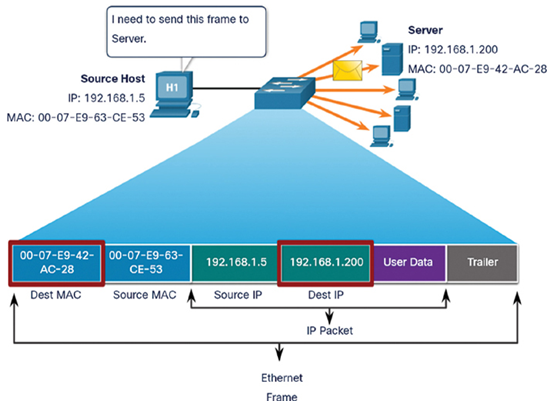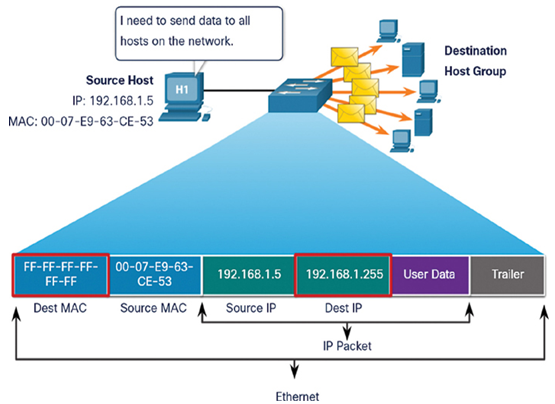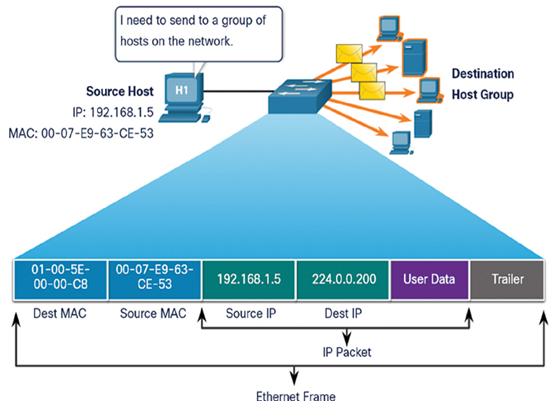In Ethernet, different MAC addresses are used for Layer 2 unicast, broadcast, and multicast communications.
A unicast MAC address is the unique address that is used when a frame is sent from a single transmitting device to a single destination device.
In Figure 21-8, the destination MAC address and the destination IP address are both unicast.

Figure 21-8 Unicast Frame Transmission
In the example shown in the animation, a host with IPv4 address 192.168.1.5 (source) requests a web page from the server at IPv4 unicast address 192.168.1.200. For a unicast packet to be sent and received, a destination IP address must be in the IP packet header. A corresponding destination MAC address must also be present in the Ethernet frame header. The IP address and MAC address combine to deliver data to one specific destination host.
The process that a source host uses to determine the destination MAC address associated with an IPv4 address is known as Address Resolution Protocol (ARP). The process that a source host uses to determine the destination MAC address associated with an IPv6 address is known as Neighbor Discovery (ND).
Note:
The source MAC address must always be a unicast.
Broadcast MAC Address (21.3.3)
An Ethernet broadcast frame is received and processed by every device on the Ethernet LAN. The features of an Ethernet broadcast are as follows:
• It has a destination MAC address of FF-FF-FF-FF-FF-FF in hexadecimal (48 ones in binary).
• It is flooded out all Ethernet switch ports except the incoming port.
• It is not forwarded by a router.
If the encapsulated data is an IPv4 broadcast packet, this means the packet contains a destination IPv4 address that has all ones (1s) in the host portion. This numbering in the address means that all hosts on that local network (broadcast domain) will receive and process the packet.
In Figure 21-9, the destination MAC address and destination IP address are both broadcasts.

Figure 21-9 Broadcast Frame Transmission
As shown in the animation, the source host sends an IPv4 broadcast packet to all devices on its network. The IPv4 destination address is a broadcast address, 192.168.1.255. When the IPv4 broadcast packet is encapsulated in the Ethernet frame, the destination MAC address is the broadcast MAC address of FF-FF-FF-FF-FF-FF in hexadecimal (48 ones in binary).
DHCP for IPv4 is an example of a protocol that uses Ethernet and IPv4 broadcast addresses.
However, not all Ethernet broadcasts carry an IPv4 broadcast packet. For example, ARP Requests do not use IPv4, but the ARP message is sent as an Ethernet broadcast.
Multicast MAC Address (21.3.4)
An Ethernet multicast frame is received and processed by a group of devices on the Ethernet LAN that belong to the same multicast group. The features of an Ethernet multicast are as follows:
• There is a destination MAC address of 01-00-5E when the encapsulated data is an IPv4 multicast packet and a destination MAC address of 33-33 when the encapsulated data is an IPv6 multicast packet.
• There are other reserved multicast destination MAC addresses for when the encapsulated data is not IP, such as Spanning Tree Protocol (STP) and Link Layer Discovery Protocol (LLDP).
• It is flooded out all Ethernet switch ports except the incoming port, unless the switch is configured for multicast snooping.
• It is not forwarded by a router, unless the router is configured to route multicast packets.
If the encapsulated data is an IP multicast packet, the devices that belong to a multicast group are assigned a multicast group IP address. The range of IPv4 multicast addresses is 224.0.0.0 to 239.255.255.255. The range of IPv6 multicast addresses begins with ff00::/8. Because multicast addresses represent a group of addresses (sometimes called a host group), they can only be used as the destination of a packet. The source will always be a unicast address.
As with the unicast and broadcast addresses, the multicast IP address requires a corresponding multicast MAC address to deliver frames on a local network. The multicast MAC address is associated with, and uses addressing information from, the IPv4 or IPv6 multicast address.
In Figure 21-10, the destination MAC address and destination IP address are both multicasts.

Figure 21-10 Multicast Frame Transmission
Routing protocols and other network protocols use multicast addressing. Applications such as video and imaging software may also use multicast addressing, although multicast applications are not as common.
Check Your Understanding – Ethernet MAC Address (21.3.5)
Refer to the online course to complete this activity.
